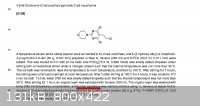
radagast - 21-2-2013 at 09:14
Hi all,
I'm having trouble understanding the reference to "azeotropy" in the attached excerpt (underlined in bright red).
That excerpt comes from a patent re: the synthesis of a PI3K inhibitor, and describes the chlorination of a triolpyrimidine with POCl3. During the
workup of the chlorinated product, the authors extracted the product with toulene, washed it with brine, and carried out "further azeotropy (twice)
with 1L of toluene".
My impression was that azeotropy was typically discussed in connection with distillation, but there is no mention of distillation used to workup the
product. Further, the product is apparently a solid at room temperature, so I doubt that they used distillation to purify it.
Can anyone shed some light on what the authors mean by that term? I thought they might mean that they extracted the aqueous solution again with
toluene, but I'm not sure that's right, either.

[Edited on 21-2-2013 by radagast]
Nicodem - 21-2-2013 at 09:41
It only means that they removed all the moisture and other volatiles during the rotavaping step by using toluene. I also prefer this over drying above
Na2SO4 or MgSO4, but the volumes they used appear as an exaggeration (twice a liter of toluene for 56 g of the product already rotavaped from 1 L
toluene?). I would understand that, if they were trying to remove the remains of DIPEA, but that was washed away during the workup as the
hydrochloride.
radagast - 21-2-2013 at 10:28
Thanks very much, Nicodem -- this is very helpful!
